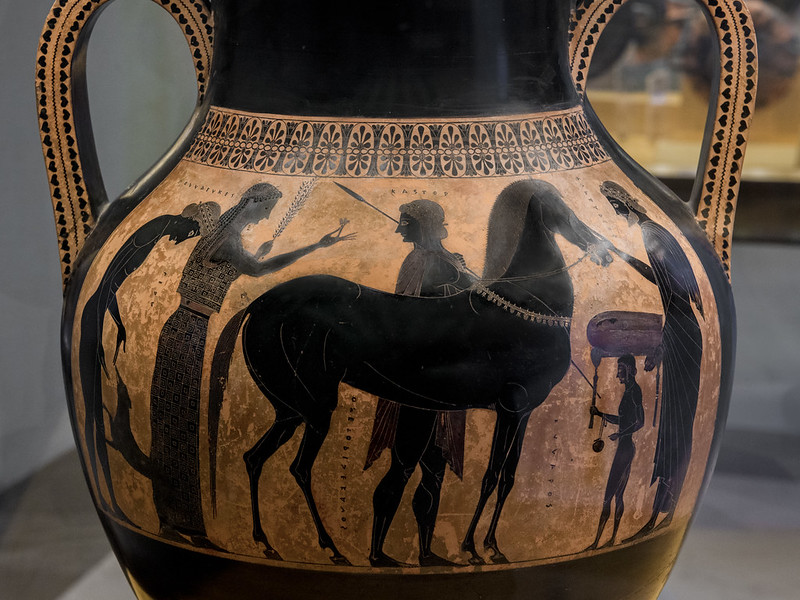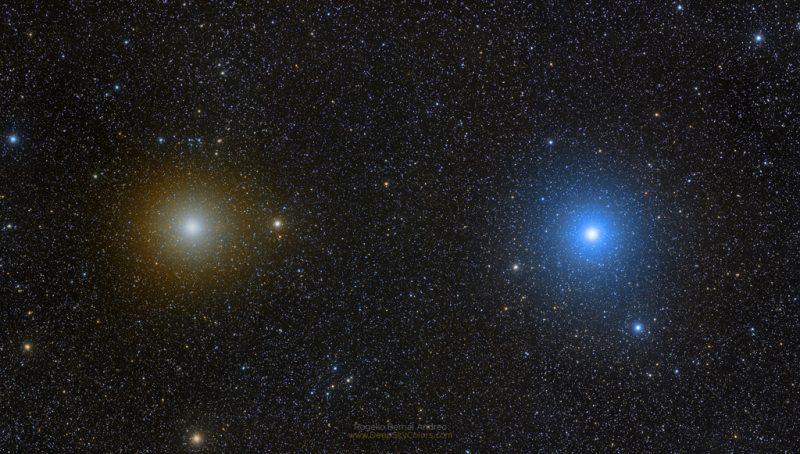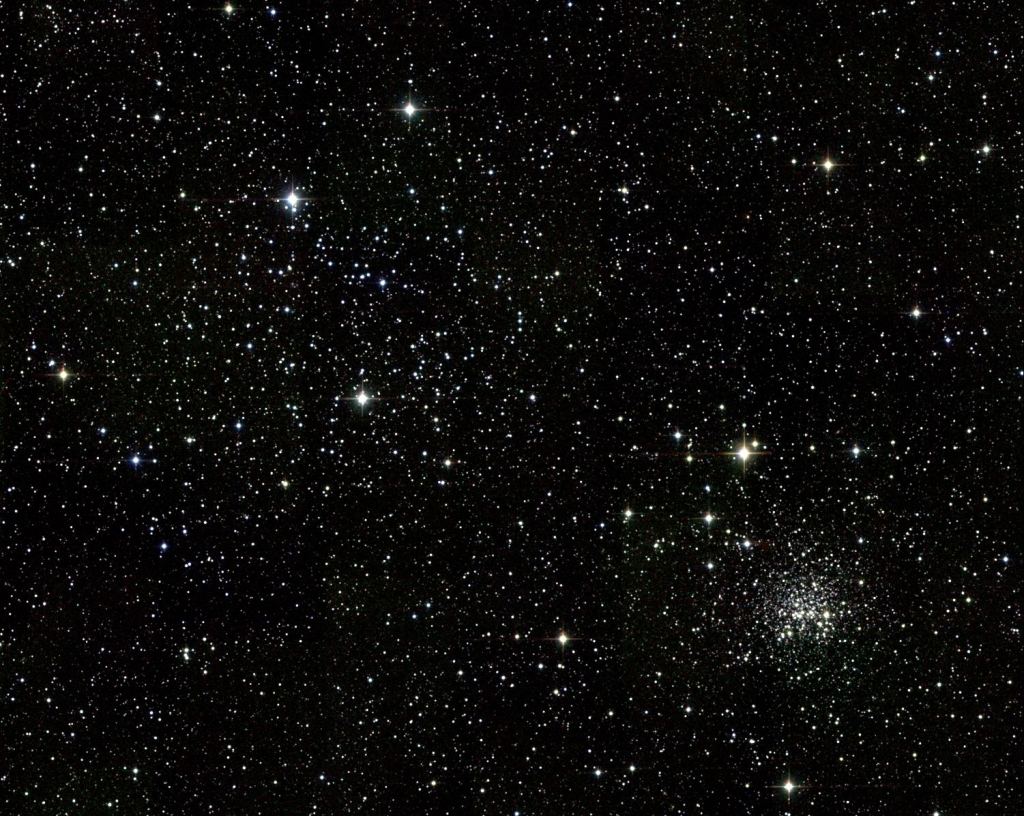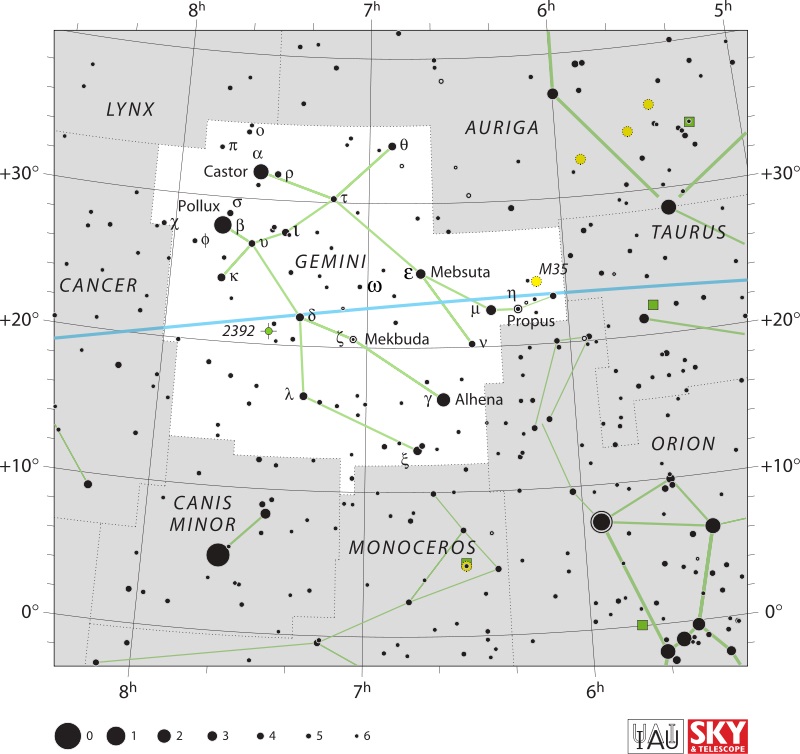Welcome to another edition of Constellation Friday! Today, in honor of the late and great Tammy Plotner, we take a look at “the Twins” – the Gemini constellation. Enjoy!
In the 2nd century CE, Greek-Egyptian astronomer Claudius Ptolemaeus (aka. Ptolemy) compiled a list of the then-known 48 constellations, the sum total of thousands of years worth of stargazing and charting the heavens. This treatise, known as the Almagest, would be used by medieval European and Islamic scholars for over a thousand years to come, effectively making it the astrological and astronomical canon until the early Modern Age.
One of the original 48 is Gemini, a constellation located on the ecliptic plane between Taurus (to the west) and Cancer (to the east). Its brightest stars are Castor and Pollux, which are easy to spot and represent the “Twins,” which is where it got its nickname. Gemini is bordered by the constellations of Lynx, Auriga, Taurus, Orion, Monoceros, Canis Minor, and Cancer, and has since become part of the 88 modern constellations recognized by the International Astronomical Union.
Name and Meaning:
In mythology, Gemini is associated with the Greek myth of Castor and Polydeuces. The two brothers Castor and Pollux were identical twins, so no one could tell them apart. According to legend, they joined Jason’s expedition aboard the Argo to the Black Sea in search of the Golden Fleece. When the Argo stopped at the entrance to the King Amycus’ realm, the king challenged them to a boxing match – mainly because no one ever survived.

The brothers were known to be fit and ready, so Pollux was the first Argonaut to take on the challenge. As soon as he got a clear shot, Pollux drove his fist into Amycus’ temple, crushing his skull and ended the battle. However, the tale ends rather sadly. Their final adventure took them to lands of Arcadia with two cousins (ex-Argonauts) to raid cattle. When their ill-gotten booty was divided, the cousins took the loot and ran. Of course, Castor and Pollux followed, taking a shortcut to wait.
Unfortunately, a cousin discovered Castor first shot him. When Pollux avenged his brother, the other cousin knocked him unconscious with a rock and went in for the kill. Luckily, Zeus was watching and ended the ordeal with a thunderbolt. When Pollux regained consciousness and realized Castor was join, he begged Zeus to remove his immortality. Zeus granted his wish and placed the twins in the sky to remind us of all of brotherly love.
History of Observation:
The Gemini constellation and “The Twins” have been recognized by cultures since ancient times. To the ancient Babylonians, the stars were known as the Great Twins and were identified as the minor gods Meshlamtaea and Lugalirra – which translates to “The One who has arisen from the Underworld” and the “Mighty King” (respectively). Both of these names were titles held by Nergal, the god of plague, pestilence, and the king of the Underworld.
In Egyptian astrology, the constellation was identified with two goats, while Arabian astrology associated them with twin peacocks. To the Romans (who transmitted the Greek association with Castor and Pollux to Europe), these stars were often identified with the brothers Romulus and Remus – the legendary founders of Rome. To Chinese astronomers, the stars that are part of Gemini are located in two corners of the zodiac: the White Tiger of the West (X? F?ng Bái H?) and the Vermillion Bird of the South (Nán F?ng Zh? Què).
In 147 or 148 CE, Ptolemy included Gemini as one of the 48 constellations contained within the Almagest. In 1930, the International Astronomical Union (IAU) included Gemini and its current boundaries in their official list of the 88 modern constellations.

Notable Features:
There are two annual meteor showers associated with the constellation of Gemini. The first peaks on or around the date of March 22nd, and are referred to as the March Geminids. This Geminid meteor shower was first discovered in 1973 and then confirmed in 1975. The average fall rate is generally about 40 per hour, but the meteoroid stream is unstudied and it may vary. These appear to be very slow meteors, entering our atmosphere unhurriedly and leaving lasting trails.
The second meteor shower associated with Gemini are the Geminids themselves, which peak on or near the date of December 14th, with activity beginning up to two weeks prior and last several days beyond the date. The Geminids are one of the most hauntingly beautiful and mysterious displays of celestial fireworks all year – first noted in 1862 by Robert P. Greg in England, and B. V. Marsh and Prof. Alex C. Twining of the United States in independent studies.
The annual appearance of the Geminid stream was weak initially, producing no more than a few per hour, but it has grown in intensity during the last century and a half. By 1877, astronomers had realized this was a new annual shower – producing about 14 meteors per hour. At the turn of the last century, the rate had increased to over 20; and by the 1930s, up to 70 per hour. Only ten years ago observers recorded an outstanding 110 per hour during a moonless night…
So why are the Geminids such a mystery? Most meteor showers are historic – documented and recorded for hundreds of years – and we know them as originating with cometary debris. But when astronomers began looking for the Geminids’ parent comet, they found none. It wasn’t until October 11th, 1983, that Simon Green and John K. Davies, using data from NASA’s Infrared Astronomical Satellite, detected an object (confirmed the next night by Charles Kowal) that matched the orbit of the Geminid meteoroid stream.
But this was no comet, it was an asteroid – in fact, a 14th magnitude asteroid which is passing Earth tonight from a distance of less than 18 million kilometers! Now considered a Potential Hazardous Asteroid (PHA), 3200 Phaeton comes within 3.2 million kilometers of Earth’s orbit about every 17 months. Originally designated as 1983 TB, but later renamed 3200 Phaethon, this apparently rocky solar system member has a highly elliptical orbit that places it within 0.15 AU of the Sun during every solar system tour.

But asteroids can’t fragment like a comet – or can they? The original hypothesis was that since Phaethon’s orbit passes through the asteroid belt, it may have collided with one or more asteroids, creating rocky debris. This sounded good, but the more we studied the more we realized the meteoroid “path” occurred when Phaethon neared the Sun. So now our asteroid is behaving like a comet, yet it doesn’t develop a tail.
So what exactly is this “thing?” Well, we do know that 5.1 kilometer diameter Phaethon orbits like a comet, yet has the spectral signature of an asteroid. By studying photographs of the meteor showers, scientists have determined that the meteors are denser than cometary material, yet not as dense as asteroid fragments. This leads them to believe Phaethon is probably an extinct comet which has gathered a thick layer of interplanetary dust during its travels, yet retains the ice-like nucleus. Until we are able to take physical samples of this “mystery,” we may never fully understand what Phaethon is, but we can fully appreciate the annual display it produces!
Thanks to the wide path of the stream, folks the world over get an opportunity to enjoy the show of the Geminids. The traditional peak time is the night of the 13th into the morning of the 14th of December – as soon as the constellation of Gemini appears, around mid-evening. The radiant for the shower is near the bright star Castor, but meteors can originate from many points in the sky. From around 2 AM tonight until dawn (when our local sky window is aimed directly into the stream) it is possible to see about one “shooting star” every 30 seconds.
The most successful of observing nights are ones where you are comfortable, so be sure to use a reclining chair or pad on the ground while looking up… And dress warmly! Please get away from light sources when possible – it will triple the amount of meteors you see.
Finding Gemini:
Gemini is bordered by the constellations of Lynx, Auriga, Taurus, Orion, Monoceros, Canis Minor, and Cancer. It can be viewed by all observers located at latitudes between +90° and -60° and is best seen at culmination during the month of February. It covers approximately 54 square degrees of sky and contains 17 main stars in the asterism, with 80 stars possessing Bayer/Flamsteed designations. For binocular observers, Gemini has a wealth of treasures. But to find things, you’ve got to know your way around!

Let’s start first with Alpha Geminorum – the “a” symbol on our map. This is Castor. Although it might look like just a single star in binoculars, it’s really quite an outstanding triple star system in a telescope. Here you will find two similar magnitude stars separated by just a few seconds of arc – and both of these stars are binary stars, too! The faint, distant orange star, Castor C, is also a double star, consisting of nearly identical, low-mass M stars – red dwarfs – and either one, or both of these are flare stars. Pretty remarkable, huh?
Now, go look at brighter Beta Geminorum, the “B” symbol on our map. Pollux is the 17th brightest star in the sky, and this orange giant star is unusual, too. Here we have an X-ray emitter. Pollux has a hot, outer, magnetically supported corona perhaps similar to that surrounding our Sun. But that’s not all. Beta Geminorum has an orbiting planet! That’s right. A planet that’s nearly 3 times the size of Jupiter and orbits its sun about the same distance as Mars orbits ours. So, if we were there, how big would orange giant Pollux look in the sky? Try almost 6 times larger, and belting out 16 times more radiation. Sunblock 6000 anyone?
Our next target is Delta Geminorum – the “8” shape on our map. Delta goes by the traditional name of Wasat, which means middle. Thankfully, that’s right about where it’s positioned! Wasat is positioned very close to the ecliptic plane, and it is an important star since it often gets occulted by the Moon. But that’s not all. Wasat is also a terrific double star, too. Take out the telescope and have a look at this soft white star with the disparate orange companion. It’s a tasty treat!
Now head further down the line for Gamma Geminorum – the “Y” shape on our map. Its name is Almeisan and it is about 150 light-years away from Earth. A binary star? You bet. The major star is a spectroscopic binary but be sure to look for a faint optical companion as well. Hop across the constellation to Theta Geminorum, the “n” shape. Often called Nageba, this 200 light-year distant Class A3 star is also a binary that can be split with a telescope. Look for components of magnitudes 3.60 and 5.18, separated by 2.9 arcseconds.
Last on our list of stars is Epsilon Geminorum, the backward “3”. Its name is Mebsuta and it is about 900 light-years away from our solar system. Mebsuta is a supergiant star of spectral class G5 and, compared to our Sun, is 150 times larger. Like Delta on the other side of Gemini, Epsilon is also very near the ecliptic plane and can also be occulted by the Moon or planets. Be sure to also keep an eye on Zeta Geminorum, too! It is a cepheid variable star, with very nice magnitude changes from 3.62 to 4.18 every 10.15 days. Quite worth following!

Before you put away your binoculars, travel back to Theta and make a hop over to the magnificent Messier 35. Also listed as NGC 2168, the awesome open star cluster was discovered by Philippe Loys de Chéseaux in 1745 and independently discovered by John Bevis before 1750. Progressively larger optics will reveal more and more stars… several hundred stars in an area about the size of the full moon. Perhaps 100 million years old, this collection of stellar gems contains several yellow and orange giant stars to delight the eye – but large telescopes will see something else.
Located about 15 arc minutes southwest of M35 is another galactic cluster – NGC 2158. At low magnification, it will appear almost like a faint globular cluster – and with good reason. NGC 2158 is over 10 times older and over five times more remote than M35! About 50 arc minutes west from M35, a faint, loose open cluster IC 2157 can also be found. For those with ultra-widefield eyepieces, you can often showcase all three objects in the same field of view!
For the telescope, there’s no place like NGC 2392 (RA 7:29; Dec 20:55) about 4 degrees east/southeast of Wasat. Better known as the “Eskimo Nebula”, this planetary nebula has a bright central region and the surrounding dim ring structure. Be sure to up the magnification in even a small telescope on this one. This stellar relic was first spied by William Herschel in 1787 and is a bubble of material being blown into space by the central star’s intense “wind” of high-speed material. Try adding a nebula filter to bring out different and subtle details!
Head now for NGC 2266 (RA 06 43.2 Dec +26 58). This open cluster is probably a billion years old – nearly all of its members evolved to the red giant star phase. From its position high above the galactic plane, low metallicity NGC 2266 has escaped the mixing of dust and gases contained in the rest of the Milky Way and become the perfect laboratory for studying stellar evolution. Look for a relatively well-compressed area of looping faint stars with a combined magnitude of near 10.
Care to try NGC 2420? You’ll find it located at RA 07 38.5 Dec +21 34. This near 8th magnitude galactic star cluster is rich in solar-type stars – another scientific playground for learning about the origins and evolution of the Milky Way. With nearly 1000 stars packed densely together in a small region, NGC 2420 originally belonged to another small galaxy that was cannibalized by our own. With an estimated age of 1.7 billion years old, it remains a curiosity because it is moving rapidly through space – and because it hasn’t been tidally pulled apart by our galactic disc. Enjoy this unique view!
There are other star clusters to enjoy in the constellation of Gemini as well, so get a good star chart and enjoy your time with the “Twins”!
We have written many interesting articles about the constellation here at Universe Today. Here is What Are The Constellations?, What Is The Zodiac?, and Zodiac Signs And Their Dates.
Be sure to check out The Messier Catalog while you’re at it!
For more information, check out the IAUs list of Constellations, and the Students for the Exploration and Development of Space page on Canes Venatici and Constellation Families.
Sources:
- SEDS – Constellation Gemini
- Earthsky – Constellation Gemini
- Wikipedia – Gemini (constellation)
- NASA Chandra Observatory – Gemini (twins)
- Windows to the Universe – Constellation: Gemini
The post The Gemini Constellation appeared first on Universe Today.
No comments:
Post a Comment